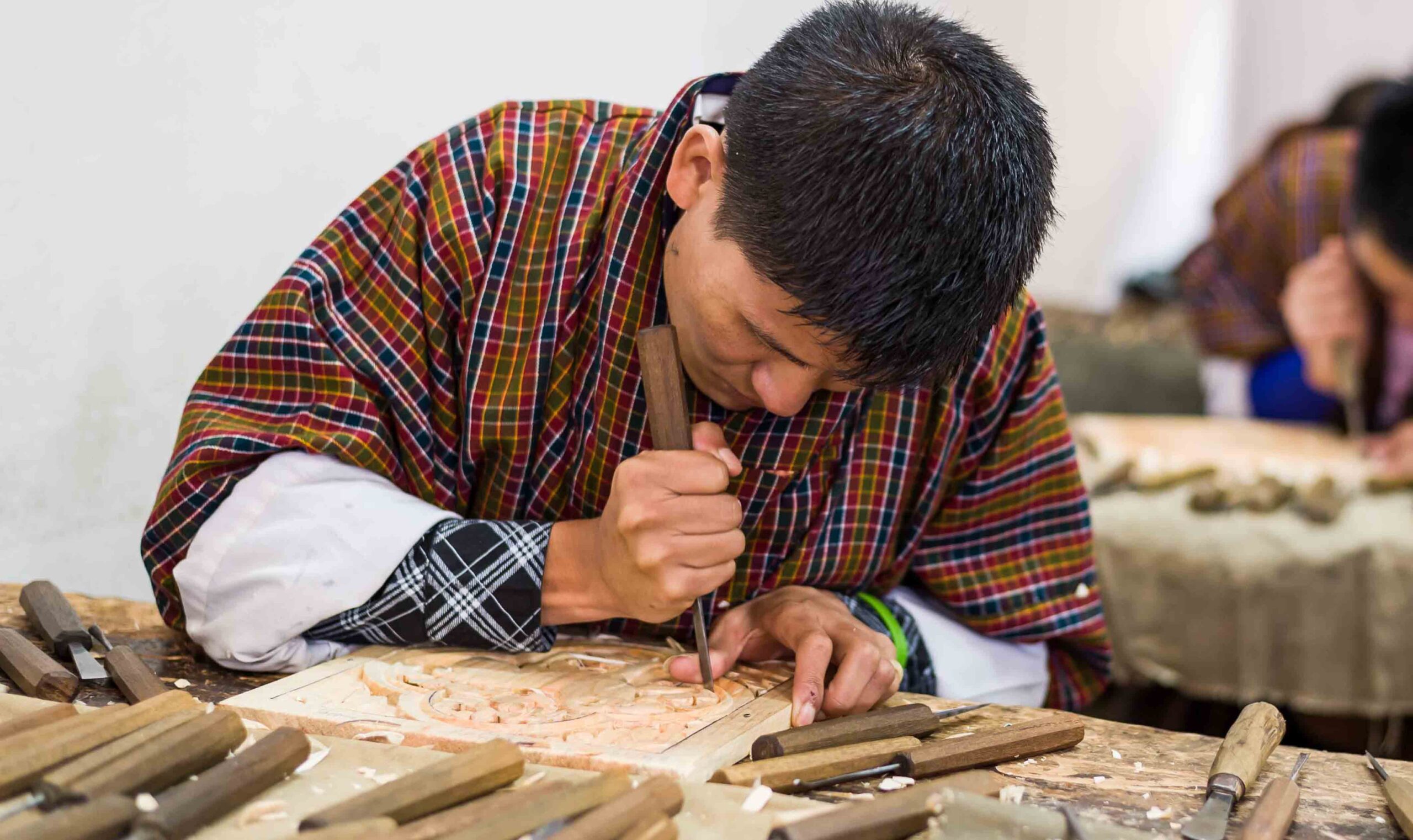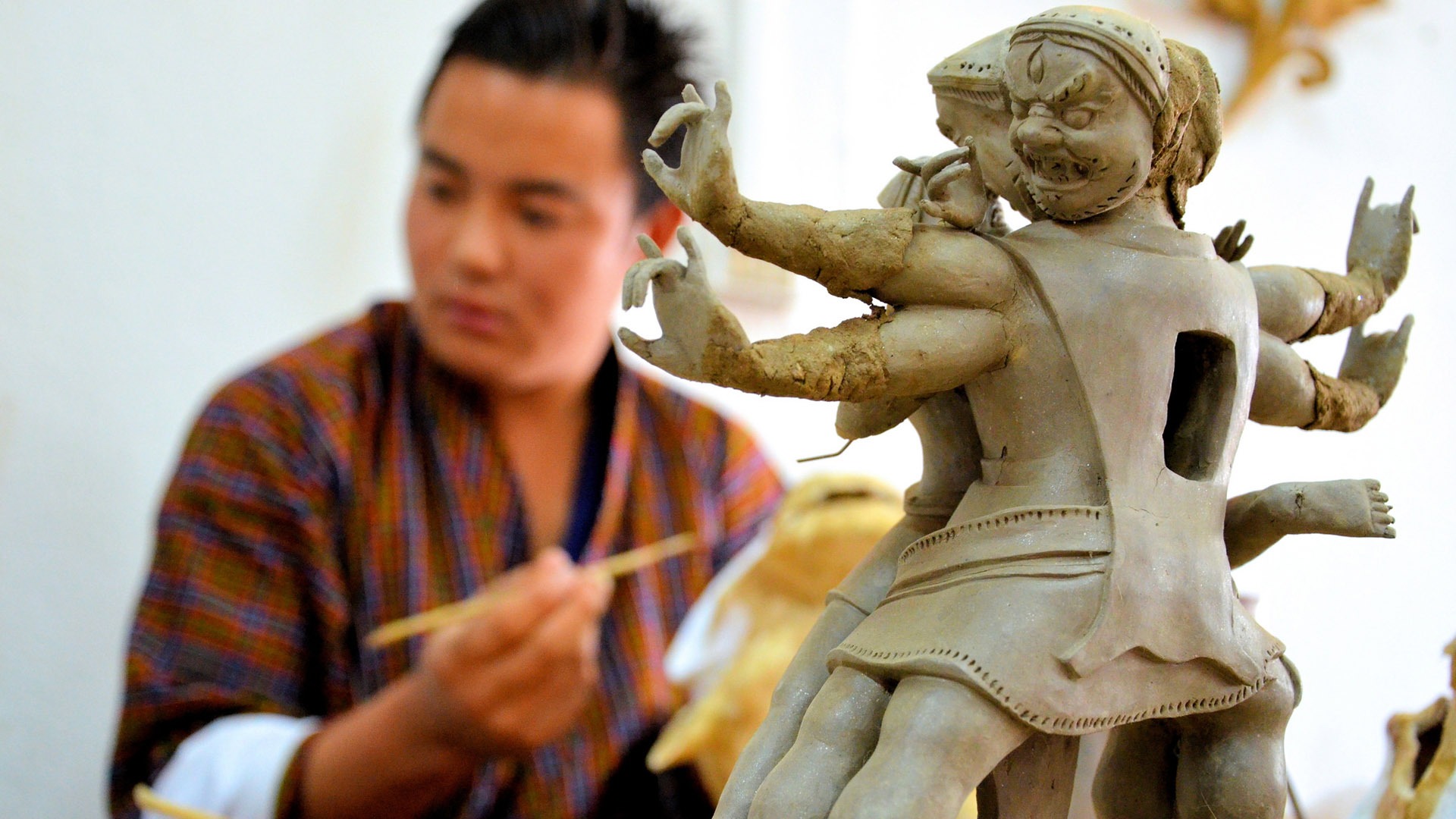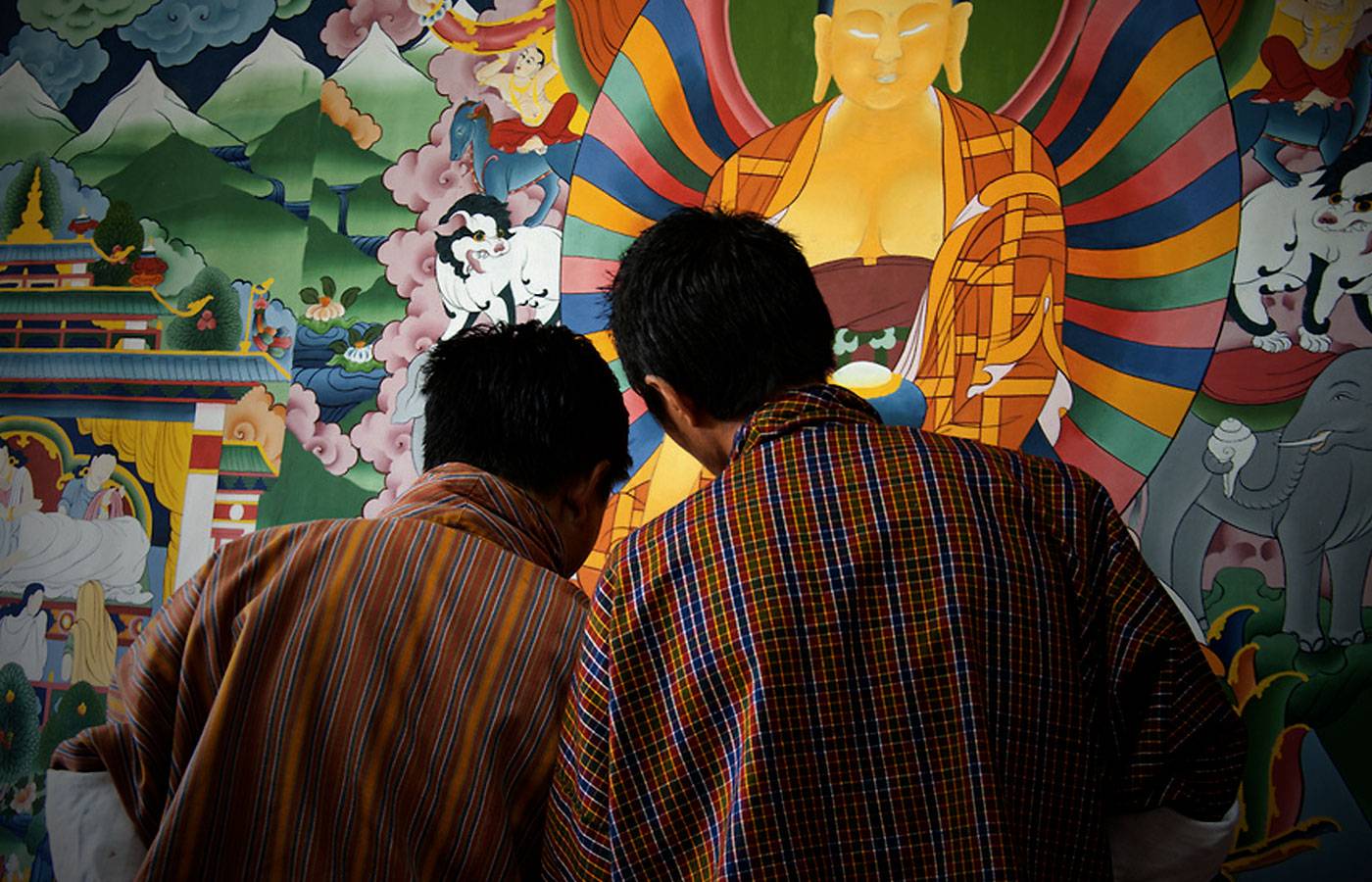Bhutan, the “Land of the Thunder Dragon,” boasts a rich cultural heritage deeply rooted in its traditional arts and crafts, collectively known as Zorig Chusum (བཟོ་རིག་བཅུ་གསུམ་). This classification encompasses thirteen distinct domains, each reflecting the nation’s spiritual ethos and artistic ingenuity. These arts are not just creative expressions but integral to Bhutan’s cultural identity, preserved through generations by skilled artisans. For luxury travelers interested in Bhutan’s heritage, a tour focused on Zorig Chusum offers a unique blend of history, culture, and artistic splendor.

-
Calligraphy (Yigzo)
The art of calligraphy in Bhutan, or yigzo (ཡིག་བཟོ་), involves creating exquisite handwritten manuscripts and ornamental books. Scribes in monastic settings meticulously produce religious texts with artistic precision. Calligraphy often includes making ink and pens, giving visitors insight into this delicate craft. Witnessing the process is a profound way to appreciate Bhutan’s literary and spiritual traditions.
-
Painting (Lhazo)
Lhazo (ལྷ་བཟོ་), or fine art, is an elevated cultural practice. Bhutanese painters, trained in sacred iconography, create intricate images of deities, mandalas, and scenes from Buddhist lore. Using handmade pigments and brushes, these artists transform walls and canvases into vibrant depictions of spiritual themes. Luxury travelers can visit workshops where they can observe or even participate in this meditative art form.
-
Carving (Parzo)
Carving, or parzo (སྤར་བཟོ་), manifests in exquisite wooden sculptures, intricate masks, and decorative elements found in Bhutanese architecture. Artisans painstakingly craft these items, often using traditional tools. Visitors can explore carving studios and observe the dedication and skill that go into creating these timeless pieces.
-
Clay Sculpture (Jinzo)

Jinzo (འཇིམ་བཟོ་) represents the art of clay sculpting, integral to crafting religious statues and ceremonial artifacts. Sculptors mold clay into deities, which are then painted and gilded. Luxury tours often include visits to workshops where travelers can learn about the spiritual significance of this craft.
-
Metal Casting (Lugzo)
The art of metal casting, or lugzo (བླུག་བཟོ་), is a revered craft in Bhutan. Artisans create ritual items like bells, cymbals, and statues using traditional methods. Observing the process of smelting and casting metal in workshops provides travelers a rare glimpse into Bhutanese craftsmanship.
-
Silver and Gold Smithery (Troezo)
Troezo (སྤྲོས་བཟོ་), or the art of gold and silver smithing, is used to create jewelry, ornaments, and ceremonial items. This craft is celebrated for its intricate designs and attention to detail. Visitors can admire master artisans at work or purchase bespoke pieces as mementos.
-
Needlework (Tshemzo)
Needlework, or tshemzo (ཚེམ་བཟོ་), includes embroidery, applique, and tailoring. Traditional Bhutanese attire, like the gho and kira, is embellished with patterns that tell stories of Bhutan’s rich history and culture. Luxury travelers can visit weaving and tailoring studios to appreciate or even learn the skills behind this craft.
-
Woodwork/Carpentry (Shingzo)

Shingzo (ཤིང་བཟོ་) embodies the craft of woodworking and carpentry, crucial for constructing Bhutan’s iconic dzongs, monasteries, and homes. The architectural elegance of Bhutan’s buildings is a testament to this art. Luxury tours often include guided visits to heritage sites showcasing this craftsmanship.
-
Textile Production (Thagzo)
Thagzo (ཐགས་བཟོ་), or weaving, is a vibrant art form. Bhutanese weavers use natural fibers and traditional looms to create intricate patterns that symbolize Bhutan’s culture. Exploring weaving centers offers a sensory delight of colors and textures, making it a must-experience for luxury travelers.
-
Paper Making (Delzo)

Delzo (འདལ་བཟོ་) focuses on traditional paper-making using the daphne plant. This eco-friendly craft results in durable, handmade paper used for sacred texts and artwork. A visit to paper-making workshops lets travelers see how nature and tradition come together in this sustainable art.
-
Bamboo Craft (Tsharzo)
Tsharzo (ཚར་བཟོ་) involves crafting bamboo into baskets, mats, and containers. This versatile craft is essential for Bhutanese households. Guests can explore bamboo craft villages and purchase unique, handmade items.
-
Black Smithery (Garzo)
Garzo (མགར་བཟོ་) represents the ancient art of blacksmithing, producing tools, weapons, and ornamental items. Traditional blacksmith workshops provide an immersive experience for travelers interested in age-old forging techniques.
-
Masonry (Dozo)
Masonry, or dozo (རྡོ་བཟོ་), is an essential craft used in constructing Bhutan’s stone-based structures. Observing artisans at work during a tour reveals the enduring strength and beauty of Bhutanese architecture.
Cultural Attractions Near Zorig Chusum Schools
A luxury tour through Bhutan offers access to fascinating cultural sites near Zorig Chusum training centers. Notable places include the Simply Bhutan Museum, a living museum showcasing traditional life, and Tashichhodzong, the fortress that houses the throne room and offices of the king. Other highlights include the Dochula Pass, offering panoramic views of the Himalayas, and the serene Tango Monastery.
For those seeking spiritual immersion, Punakha Dzong, Simtokha Dzong, and Paro Rinpung Dzong are architectural masterpieces showcasing Bhutan’s Zorig Chusum traditions. These sites, nestled amidst natural beauty, provide a tranquil retreat for luxury travelers.
Festivals and Tours
Experience Bhutan’s vibrant festivals like the Black-Necked Crane Festival or the Wangdi Festival, which showcase the country’s rich culture and spiritual heritage. Winter travelers can enjoy the serenity of a Bhutan Trip in December, while trekking enthusiasts may opt for the Gangtey Trek. Luxury tours offer curated experiences, from cultural immersion to outdoor adventures, ensuring an unforgettable journey.
Practical Information
– Visiting Hours: Most cultural sites and workshops are open from 9:00 AM to 6:00 PM.
– Entrance Fees: For museums, the entry fee is INR 300 for Indian nationals and $5 for other foreign visitors.
– Accommodation: Bhutan boasts luxury stays like Como Hotels, which offer top-notch amenities and cultural experiences.
A Bhutan luxury tour centered on Zorig Chusum is an enriching journey into the heart of Bhutanese artistry and tradition. Whether exploring intricate paintings or witnessing age-old crafts, travelers gain an appreciation for Bhutan’s enduring cultural legacy.

